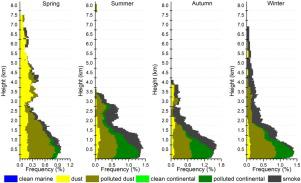Particuology ( IF 3.5 ) Pub Date : 2019-12-02 , DOI: 10.1016/j.partic.2019.10.001 Qiong Liu , Xin Liu , Tongqiang Liu , Yanming Kang , Yonghang Chen , Jiming Li , Hua Zhang

|
Although the concentration of atmospheric particulate matter in Shanghai has declined in recent years, aerosols remain one of the major pollutants affecting air quality. Herein, spatio-seasonal variation in aerosol optical properties and aerosol types were studied over a 10-year period (2006–2015) in Shanghai, China, using satellite data from Moderate Resolution Imaging Spectroradiometer (MODIS) and Cloud-Aerosol Lidar with Orthogonal Polarization (CALIOP). The average aerosol optical depth values for central urban and suburban areas of Shanghai were between 0.9 and 1.0. Clear seasonal variation in aerosol concentrations occurred, causing strongest attenuation in summer and weakest attenuation in autumn. Polluted dust, polluted continental (urban/industrial) and smoke aerosols were the main aerosol types. Desert dust aerosols occurred in the Shanghai area at higher altitudes (greater than 3 km) in spring, related to dusty weather in the north; while in winter, smoke aerosols occurred at high altitudes, related to haze pollution in the north. The aerosols detected in autumn were mainly from local sources, comprising polluted dust, polluted continental, and smoke aerosols. Aerosols in Shanghai clearly reflect both local and regional sources at different times.


























 京公网安备 11010802027423号
京公网安备 11010802027423号